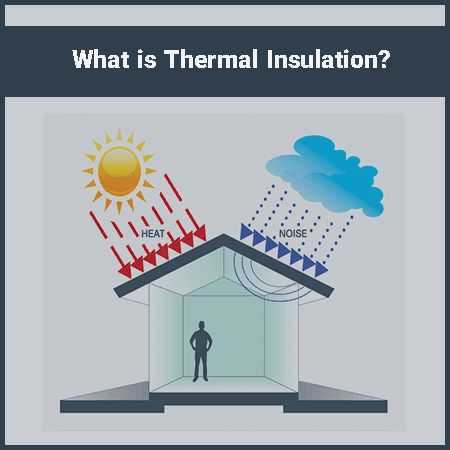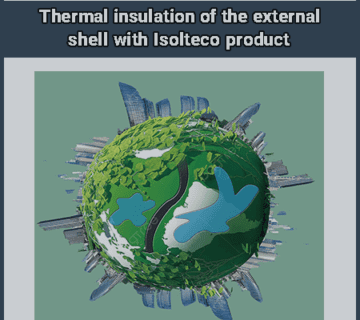In today’s world, where environmental issues and energy conservation are more important than ever, the use of thermal insulation has become a key solution for saving energy and reducing heat loss in buildings. With the rising costs of energy and its negative impacts on the environment, this importance becomes even more evident. Utilizing thermal insulation in buildings can lead to a significant reduction of up to 50% in energy consumption for heating and cooling, ultimately resulting in financial savings and environmental preservation. In this article, we will explore what thermal insulation is and how it functions within buildings.
What is thermal insulation?
Thermal insulation in buildings is one of the most important factors for reducing heat transfer and maintaining thermal comfort. Buildings, due to their various surfaces such as walls, roofs, floors, windows, and other parts, are constantly exposed to heat transfer. This heat transfer can occur from a warmer environment to a cooler one due to the temperature difference between the two. In other words, walls, roofs, floors, and windows act as the external shell of the building and can serve as pathways for heat transfer. For example, in cold seasons, the heat inside the building may escape through the walls to the outside, and in warm seasons, heat from the outside may enter the building. This heat transfer can negatively impact the thermal comfort inside the building and increase its energy consumption. To counteract unwanted heat transfer, thermal insulation is highly effective. These insulations are made from various materials and are designed to reduce heat transfer from one side to the other. Thermal insulation is a material that, when placed as a barrier between different surfaces of the building, prevents heat transfer from one area to another. This material is usually installed as a coating or layer on various surfaces to prevent heat from moving in or out. The primary function of thermal insulation is to create an environment with fewer temperature fluctuations, which can help save energy and provide comfort for occupants. In cold seasons, thermal insulation helps retain heat inside the space, and in warm seasons, it helps keep the interior of the building cool.
How thermal insulation works?
To better understand how thermal insulation works, we first need to become familiar with heat flow, which occurs through three main mechanisms:
1. Conduction: In this mechanism, heat is transferred from the part with a higher temperature to the part with a lower temperature. This type of heat transfer is particularly evident in solid materials. For example, in a building wall, heat is conducted from the warmer side of the wall to the cooler side.
2. Convection: This mechanism requires the presence of a fluid medium, such as air or water. In this method, heat is transferred through the movement of the fluid. A common example of this type of heat transfer is the flow of warm air around the human body, facilitated by blood circulation, or the movement of warm air in a room, generated by heating systems or heaters.
3. Radiation: In this method, heat is transferred through electromagnetic waves, and like sunlight, it can occur even in a vacuum. This method plays a significant role in heat transfer at high temperatures and transfers heat directly without the need for a medium.
Heat transfer through the external walls of a building, in the form of conduction, is the most significant factor in heat loss or gain in standard buildings.
Reducing heat conduction with various types of thermal insulation
Reducing thermal conduction through the use of thermal insulation is one of the most important methods for improving energy efficiency in buildings. Thermal conduction is the process by which heat is transferred through direct contact of materials from a higher temperature area to a lower temperature area. To reduce thermal conduction, it is essential to use insulating materials with specific properties that prevent heat transfer. Below, we will discuss how thermal conduction is reduced using thermal insulation:
1. Low Thermal Conductivity Coefficient: Thermal insulating materials typically have very low thermal conductivity coefficients. The thermal conductivity coefficient is a measure of a material’s ability to transfer heat. The lower this coefficient, the better the material performs as a thermal insulator. Materials such as rock wool, fiberglass, polystyrene foam, and polyurethane foam have low thermal conductivity coefficients.
2. Cellular or Fibrous Structure: Many insulating materials have a cellular or fibrous structure that traps air or inert gases within them. These gases, due to their low thermal conductivity, play a significant role in reducing heat transfer. For example, polyurethane foams have closed cells that trap specific gases, effectively preventing heat conduction.
3. Increasing Insulation Thickness: Increasing the thickness of insulating materials is an effective method for reducing thermal conduction. The thicker the insulation, the longer the heat transfer path becomes, requiring heat to pass through more layers. This results in a decrease in the amount of heat transferred via conduction.
4. Selecting the Right Materials: Choosing insulation materials with an appropriate thermal conductivity coefficient for each part of the building (walls, roof, floor, etc.) is crucial. Insulation materials with lower thermal conductivity are better suited for parts of the building that are more exposed to heat transfer.
5. Proper Insulation of Joints and Gaps: To effectively reduce thermal conduction, it is essential to ensure that all joints, gaps, and areas prone to heat transfer are well insulated. Using sealants and insulating tapes at window joints, doors, and other connection points can help reduce thermal conduction.
Overall, reducing thermal conduction through the use of thermal insulation leads to optimized energy consumption and increased thermal comfort in buildings. These methods not only reduce energy costs but also help mitigate the environmental impact associated with energy use.
The impact of using thermal insulation in reducing convection
Using thermal insulation on the external walls of a building has a significant impact on reducing convection. By installing thermal insulation on the walls, roof, and floor of the building, air movement within the insulation structure is limited. This restriction in airflow reduces convective fluid movement within the walls, as thermal insulations typically have closed or open cellular structures that trap air or inert gases. This feature prevents the free movement of air, thereby reducing convection. Additionally, proper insulation can effectively prevent air leakage through gaps and cracks in the external walls. This is especially important in areas subject to extreme temperature changes. By reducing air leakage, unwanted convective currents are minimized, and the heat inside the building is better retained. As a result, using thermal insulation on external walls not only increases energy efficiency and reduces heating and cooling costs but also improves thermal comfort and the quality of life for residents.
Reducing thermal radiation using thermal insulation
Using thermal insulation on the external walls of a building also helps reduce thermal radiation. Modern thermal insulations have reflective surfaces that can reflect a significant portion of thermal radiation, preventing this heat energy from penetrating into the building or escaping from it. This reflective property of thermal insulation is particularly beneficial in the summer, as it can significantly prevent the building from overheating, thereby reducing the need for cooling systems. Additionally, thermal insulation can prevent internal heat radiation from escaping to the outside, especially during cold winter nights. This feature helps retain the heat generated by the building’s heating systems, preventing it from radiating out into the external environment. This reduces the need for energy to heat the building during the winter, leading to energy cost savings and improved energy efficiency.
The most important advantages of using thermal insulation are:
Thermal insulation helps maintain an optimal environment by preventing heat loss in any system. Thermal insulation increases the comfort and well-being of building occupants throughout the year by maintaining a desirable indoor temperature and reducing the need for excessive use of heating and cooling systems during cold and hot seasons. Therefore, the role of thermal insulation in energy conservation and enhancing the efficiency of buildings is significant and should be seriously considered in the design and construction of new buildings or the renovation of older ones. For example, insulated walls can prevent 50% or more of heat loss. Additionally, thermal insulation can prevent temperature drops, humidity, and water infiltration into the building, protecting it from issues like decay and damage caused by moisture. Moreover, these insulations can also prevent risks such as fire and sound transmission.
The importance of thermal insulation in energy conservation
Thermal insulation plays a crucial role in environmental conservation. By reducing energy consumption for heating and cooling buildings, greenhouse gas emissions and other pollutants can be significantly decreased. This contributes to preserving habitats, mitigating climate change, and maintaining biodiversity. Given the importance of energy conservation and the positive impact of thermal insulation on building energy efficiency and environmental protection, promoting the use of these insulations and encouraging their application in buildings is of great importance. Additionally, educating and raising awareness about the different types of thermal insulation, their benefits, and applications can help increase the adoption of these sustainable technologies. These efforts can also contribute to achieving sustainable development goals and reducing the negative impacts of climate change.
Applications of thermal insulation
Thermal insulation is widely used in various parts of the building industry, such as walls, roofs, floors, and even windows. These insulations play a crucial role in increasing energy efficiency, reducing heating and cooling costs, and improving the thermal comfort of occupants. Below are some key categories of thermal insulation applications in buildings, along with the materials commonly used in each category:
1) Use of Thermal Insulation in Walls:
Thermal insulations in walls are used to reduce heat transfer and improve energy efficiency in buildings. These insulations can be applied or installed both internally and externally and play a crucial role in maintaining the indoor temperature of the building and reducing energy consumption.
- External Walls: For external walls, insulation materials such as mineral wool, polyurethane foam, and spray-applied mortars are commonly used. These insulations help prevent the infiltration of cold or hot air into the building, creating a more comfortable environment for occupants and reducing heating and cooling costs. One example of insulation suitable for external walls is the Isolteco thermal insulating plaster, which can be applied as a spray. The use of this product provides complete thermal insulation, soundproofing, elimination of thermal bridges, and compliance with the requirements of Chapter 19 of the National Building Regulations.
- Internal Walls: In internal walls, insulation materials such as polyurethane foam, cellulose, and spray-applied mortars are commonly used. These insulations can be applied as spray or in board form on the walls. The use of thermal insulation in internal walls not only reduces heat transfer but also helps in reducing sound transmission, creating a quieter and more peaceful environment inside the building.
Overall, wall insulation is one of the most effective ways to improve a building’s energy efficiency. It plays a significant role in maintaining a comfortable indoor temperature and reducing energy costs. →Introduction to Isolteco Thermal Insulation
2) Use of Thermal Insulation in Floors and Roofs
Using thermal insulation in floors is a crucial factor in improving the energy efficiency of buildings and enhancing the thermal comfort of occupants. Floors play a significant role in heat transfer between different levels of a building, as well as between the interior space and the external environment. Therefore, proper floor insulation can help reduce heat loss and energy costs.
- Floor Insulation: Insulating the floors, especially in multi-story buildings, is highly important. In such buildings, heat transfer between floors can lead to increased energy consumption for heating and cooling. Using insulation materials such as rock wool, fiberglass, polyurethane foam, and thermal insulating concrete can help reduce this heat transfer, creating a more comfortable and temperature-balanced environment for occupants. Additionally, insulating floor levels can also help reduce sound transmission between floors, further enhancing the comfort and privacy within the building.
- Ground Floor Insulation: In buildings where the ground floor is directly on the ground, thermal insulation of this floor is essential. This helps prevent cold from penetrating the building from the ground and maintains a comfortable indoor temperature. Insulation materials like polystyrene (both extruded XPS and expanded EPS) and thermal insulating concrete can be effective in this regard. Using XPS and EPS thermal insulation in the ground floor can reduce heating costs during cold seasons and increase the thermal comfort of occupants. Additionally, using Isolcap insulating concrete, a super lightweight thermal insulating concrete, is an excellent option for insulating the floor that is adjacent to the ground or a parking area.
- Roof InsulationRoof Insulation: Roof insulation also plays an important role in improving the energy efficiency of the building. The roof is one of the main areas where heat is transferred out of the building. Using suitable types of thermal insulation on the roof can help reduce heat loss and maintain a desirable indoor temperature. This not only reduces energy costs but also helps extend the lifespan of the roof and prevents damage caused by temperature fluctuations. The use of Isolcap thermal insulation can provide simultaneous application of the insulation layer and the slope layer, comply with the requirements of Chapter 19 of the National Building Regulations, and enhance the building’s energy rating to EC.
Overall, floor insulation, especially on different levels and the roof of the building, is one of the fundamental measures for improving energy efficiency and creating a comfortable environment with a balanced temperature in buildings.
The use of thermal insulation in roofs.
Roof insulation is one of the most effective methods for improving energy efficiency in buildings. Roofs, due to their direct exposure to the external environment, are one of the main pathways for heat transfer into or out of a building. Using thermal insulation in roofs can significantly reduce heat loss and decrease the need for heating and cooling systems.
Flat Roofs: In flat roofs, installing thermal insulation on the underside or top of the roof can prevent heat transfer. These roofs, due to their large surface area exposed to sunlight, especially require proper insulation. Thermal insulation in such roofs can prevent heat from entering in the summer and escaping in the winter, thereby reducing energy consumption and related costs.
Pitched Roofs: Thermal insulation is also highly important in pitched roofs. These roofs usually have an attic space that can act as natural insulation. However, adding layers of thermal insulation can enhance the efficiency of this space. Installing thermal insulation between the rafters or on the inner surface of the pitched roof not only reduces heat loss but also helps in reducing sound penetration.
The use of thermal insulation in roofs not only contributes to energy savings but also increases occupant comfort. By reducing temperature fluctuations inside the building, thermal insulation can create a more stable and pleasant environment. Additionally, proper roof insulation can extend the building’s lifespan and reduce the need for frequent repairs.
Isolteco thermal insulation, due to its high adhesion and the presence of special polymers and fibers, is an excellent choice for spray-applied insulation from underneath the roof. For more information on thermal insulation of the building envelope with the Isolteco product, you can visit our blog.
Features of an Ideal Thermal Insulation
Thermal insulation in buildings must meet specific criteria to be recognized as a valid thermal insulation according to Chapter 19 of the National Building Regulations. According to these regulations, the thermal insulation must have a total thermal resistance of the building envelope that is at least equivalent to a specific value of W/m.K, and the thermal conductivity of the insulation material used must be less than or equal to 0.065 m².K/W. These features are essential for reducing energy loss and improving energy efficiency in buildings. In addition to these standards, there are other general characteristics that should be considered when selecting suitable thermal insulation:
- High Thermal Resistance: Prevents energy loss and increases efficiency
- Non-toxicity: Free from harmful and hazardous materials for the building’s occupants
- Fire Resistance: High resistance to fire and reduced risk of combustion
- Pressure Resistance: Ability to withstand various structural loads
- Resistance to External Factors: Resistant to UV rays, pests, fungi, and microbes
- Appropriate Coefficient of Expansion and Contraction: Minimal volumetric changes under varying temperature conditions
- Chemical Reactivity: Chemically inert and non-reactive
- Capillarity: Allows for easy and durable installation on various surfaces
These features ensure that thermal insulation contributes to improving the building’s energy efficiency while also safeguarding the health of its occupants.




No comments